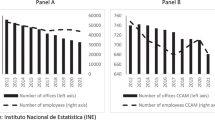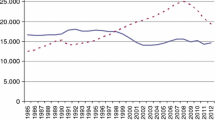Abstract—
Over the past two decades, there has been a decrease in the number of banks in Russia, both as a result of concentration and consolidation processes in the global banking industry and of the banking sector rehabilitation policy pursued by the Central Bank of the Russian Federation. As a result, banking activities in the country are now carried out mainly by banks with headquarters in the capital. The article discusses the consequences of such geographic centralization of the Russian banking sector in terms of providing regions with a sufficient number of bank branches. The aim of the study is to assess the impact of distance on banks’ ability to maintain their presence in regions, as well as to identify differences in this regard between different categories of banks, including the composition of owners, location of the head office, and size of the bank. The impact of distances on the number of bank offices in regions at the end of 2018, according to the Central Bank of the Russian Federation, is assessed using the Poisson regression method for interregional trade gravity models. The results showed that the largest banks in their office location strategy are guided by the characteristics of locales, regardless of distance from the bank’s head office. At the same time, the composition of a bank’s owners has little effect, although in fact, financial accessibility and inclusion in the country are to a large extent provided by the largest state-owned banks. The office location strategy is also linked to the location of the bank’s head office in the capital. The remaining regional banks are more likely to operate locally; for them the distance factor in the formation of a branch network is important. Despite banking licensing reform in 2018, the number of banks continues to decline and the level of competition and diversity in this sphere in Russian regions is still debatable.
Similar content being viewed by others
REFERENCES
Ageeva, S.D. and Mishura, A.V., Impact of spatial concentration of the Russian banking sector on lending to regions and small and medium-sized businesses, Vopr. Ekon., 2019, no. 1, pp. 92–108.
Ageeva, S.D. and Mishura, A.V., Geography and structure of the banking sector: trends in the world and Russia, Vopr. Ekon., 2017, no. 9, pp. 83–97.
Simanovskii, A., Morozov, A., Sinyakov, A., et al., Itogi desyatiletiya 2008–2017 godov v rossiiskom bankovskom sektore: tendentsii i faktory (The 2008–2017 Decade in the Russian Banking Sector: Trends and Factors), Moscow: Tsentr. Bank Ross. Fed., 2018, no. 31.
Alama, L. and Tortosa-Ausina, E., Bank branch geographic location patterns in Spain: some implications for financial exclusion, Growth Change, 2012, vol. 43, no. 3, pp. 505–543.
Alessandrini, P., Fratianni, M., Papi, L., and Zazzaro, A., Banks, regions and development after the crisis and under the new regulatory system, Credit Cap. Markets, 2016, vol. 49, no. 4, pp. 535–561.
Bernini, C. and Brighi, P., Bank branches expansion, efficiency and local economic growth, Reg. Stud., 2018, vol. 52, no. 10, pp. 1332–1345.
Buch, C. and DeLong, G., Cross-border bank mergers: What lures the rare animals? J. Banking Fin., 2004, vol. 28, no. 9, pp. 2077–2102.
Felici, R. and Pagnini, M., Distance, bank heterogeneity and entry in local banking markets, J. Ind. Econ., 2008, vol. 56, no. 3, pp. 500–534.
Fiogel, F., Distance, Rating Systems and Enterprise Finance: Ethnographic Insights from a Comparison of Regional and Large Banks in Germany, London: Routledge, 2019.
Focarelli, D. and Pozzolo, A., Where do banks expand abroad? An empirical analysis, J. Bus., 2005, vol. 78, no. 6, pp. 2435–2464.
Fuentelsaz, L. and Gómez, J., Multipoint competition, strategic similarity and entry into geographic markets, Strategic Manage. J., 2006, vol. 27, no. 5, pp. 477–499.
Huang, C., Spatial competition of the bank branch networks in Taiwan. http://econ.ccu.edu.tw/manage/1520231611_a.pdf. Accessed May 15, 2019.
Klagge, B., Martin, R., and Sunley, P., The spatial structure of the financial system and the funding of regional business: a comparison of Britain and Germany, in Handbook of Geographies of Money and Finance, Martin, R. and Pollard, J., Eds., Cheltenham: E. Elgar, 2017, pp. 125–155.
Magri, S., Mori, A., and Rossi, P., The entry and the activity level of foreign banks in Italy: an analysis of the determinants, J. Banking Fin., 2005, vol. 29, no. 5, pp. 1295–1310.
Nagano, M. and Ushijima, T., What drives interregional bank branch closure? The case of Japan’s regional banks in the post-deregulation period, Int. Rev. Fin., 2018, vol. 18, no. 4, pp. 595–635.
Papi, L., Sarno, E., and Zazzaro, A., The geographical network of bank organizations: issues and evidence for Italy, in Handbook of Geographies of Money and Finance, Martin, R. and Pollard, J., Eds., Cheltenham: E. Elgar, 2017, pp. 156–197.
Presbitero, A., Udell, G., and Zazzaro, A., The home bias and the credit crunch: a regional perspective, J. Money Credit Banking, 2014, vol. 46, pp. 53–85.
Silva, J. and Tenreyro, S., The log of gravity, Rev. Econ. Stat., 2006, vol. 88, no. 4, pp. 641–658.
Udell, G., Financial innovation, organizations and small business lending, in The Changing Geography of Banking and Finance, Alessandrini, P., Fratianni, M., and Zazzaro, A., Eds., New York: Springer-Verlag, 2009, pp. 15–26.
Vernikov, A., A Guide to Russian Bank Data: Breaking Down the Sample of Banks: SSRN Discussion Paper No. 2600738, Moscow: Central Bank Russ., 2018.
Funding
The article was prepared according to the research plan of IEIE SB RAS under projects XI.172.1.1 “Integration and Interaction of Industry Systems and Markets in Russia and Its Eastern Regions: Limitations and New Opportunities” no. АААА-А17-117022250132-2 and XI.174.1.2 “Fundamental Approaches to Forming Relationships Between the Main Participants in the Development of Mineral Resources in the Asian Part of Russia in the Context of Global Challenges of the 20th century” no. AAAA-A14-117022250131-5.
Author information
Authors and Affiliations
Corresponding authors
Ethics declarations
The authors declare that they have no conflict of interest.
Rights and permissions
About this article
Cite this article
Mishura, A.V., Ageeva, S.D. Providing Banking Branches in Russian Regions: Assessment of the Role of Distance and Other Factors. Reg. Res. Russ. 10, 506–512 (2020). https://doi.org/10.1134/S2079970520040061
Received:
Revised:
Accepted:
Published:
Issue Date:
DOI: https://doi.org/10.1134/S2079970520040061




